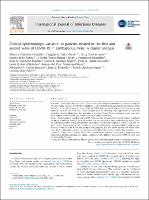| dc.contributor.author | Valladares Garrido, Mario J. | |
| dc.contributor.author | Failoc-Rojas, Virgilio E. | |
| dc.contributor.author | Soto-Becerra, Percy | |
| dc.contributor.author | Zeña Ñañez, Sandra | |
| dc.contributor.author | Torres-Roman, J. Smith | |
| dc.contributor.author | Fernández-Mogollón, Jorge L. | |
| dc.contributor.author | Colchado-Palacios, Irina G. | |
| dc.contributor.author | Apolaya-Segura, Carlos E. | |
| dc.contributor.author | Dávila-Gonzales, Jhoni A. | |
| dc.contributor.author | Arce-Villalobos, Laura R. | |
| dc.contributor.author | Neciosup-Puican, Roxana del Pilar | |
| dc.contributor.author | Calvay-Requejo, Alexander G. | |
| dc.contributor.author | Maguiña, Jorge L. | |
| dc.contributor.author | Apolaya-Segura, Moisés | |
| dc.contributor.author | Díaz-Vélez, Cristian | |
| dc.date.accessioned | 2023-03-21T18:05:20Z | |
| dc.date.available | 2023-03-21T18:05:20Z | |
| dc.date.issued | 2022-10 | |
| dc.identifier.citation | International Journal of Infectious Diseases. 2020;123. | es_PE |
| dc.identifier.issn | 1201-9712 | |
| dc.identifier.uri | https://hdl.handle.net/20.500.12959/3482 | |
| dc.description.abstract | Objectives: To identify differences in the clinical and epidemiologic characteristics of patients during the first and second waves of the COVID-19 pandemic at the EsSalud Lambayeque health care network, Peru.
Methods: An analytical cross-sectional study of 53,912 patients enrolled during the first and second waves of COVID-19 was conducted. Cluster analysis based on clustering large applications (CLARA) was applied to clinical-epidemiologic data presented at the time of care. The two pandemic waves were compared using clinical-epidemiologic data from epidemiologic surveillance.
Results: Cluster analysis identified four COVID-19 groups with a characteristic pattern. Cluster 1 included the largest number of participants in both waves, and the participants were predominantly female. Cluster 2 included patients with gastrointestinal, respiratory, and systemic symptoms. Cluster 3 was the “severe” cluster, characterized by older adults and patients with dyspnea or comorbidities (cardiovascular, diabetes, obesity). Cluster 4 included asymptomatic, pregnant, and less severe patients. We found differences in all clinical-epidemiologic characteristics according to the cluster to which they belonged.
Conclusion: Using cluster analysis, we identified characteristic patterns in each group. Respiratory, gastrointestinal, dyspnea, anosmia, and ageusia symptoms were higher in the second COVID-19 wave than the first COVID-19 wave. | es_PE |
| dc.description.abstract | Objetivos: Identificar diferencias en las características clínicas y epidemiológicas de los pacientes durante la primera y segunda ola de la pandemia de COVID-19 en la red de atención de salud de EsSalud Lambayeque, Perú.
Métodos: Se realizó un estudio transversal analítico de 53.912 pacientes inscritos durante la primera y segunda ola de COVID-19. Se aplicó el análisis de conglomerados basado en la agrupación de grandes aplicaciones (CLARA) a los datos clínico-epidemiológicos presentados en el momento de la atención. Las dos olas pandémicas se compararon utilizando datos clínico-epidemiológicos de vigilancia epidemiológica.
Resultados: El análisis de conglomerados identificó cuatro grupos de COVID-19 con un patrón característico. El grupo 1 incluyó la mayor cantidad de participantes en ambas oleadas, y los participantes eran predominantemente mujeres. El grupo 2 incluyó pacientes con síntomas gastrointestinales, respiratorios y sistémicos. El cluster 3 fue el cluster “grave”, caracterizado por adultos mayores y pacientes con disnea o comorbilidades (cardiovasculares, diabetes, obesidad). El grupo 4 incluyó pacientes asintomáticos, embarazadas y menos graves. Encontramos diferencias en todas las características clínico-epidemiológicas según el conglomerado al que pertenecían.
Conclusión: Utilizando el análisis de conglomerados, identificamos patrones característicos en cada grupo. Los síntomas respiratorios, gastrointestinales, disnea, anosmia y ageusia fueron más altos en la segunda ola de COVID-19 que en la primera ola de COVID-19. | es_PE |
| dc.format | application/pdf | es_PE |
| dc.language.iso | eng | es_PE |
| dc.publisher | International Society for Infectious Diseases | es_PE |
| dc.relation.uri | https://www.sciencedirect.com/science/article/pii/S1201971222004428 | es_PE |
| dc.rights | info:eu-repo/semantics/openAccess | es_PE |
| dc.rights.uri | https://creativecommons.org/licenses/by-nc-sa/4.0/ | es_PE |
| dc.subject | Covid-19 | es_PE |
| dc.subject | Cluster analysis | es_PE |
| dc.subject | Coronavirus infections | es_PE |
| dc.subject | Pandemic wave | es_PE |
| dc.subject | Symptoms | es_PE |
| dc.subject | Análisis de conglomerados | es_PE |
| dc.subject | Contagio de coronavirus | es_PE |
| dc.subject | Ola pandémica | es_PE |
| dc.subject | Síntomas | es_PE |
| dc.subject | Perú | es_PE |
| dc.title | Clinical-epidemiologic variation in patients treated in the first and second wave of COVID-19 in Lambayeque, Peru: A cluster analysis | es_PE |
| dc.title.alternative | Variación clínico-epidemiológica en pacientes atendidos en la primera y segunda ola de COVID-19 en Lambayeque, Perú: un análisis de conglomerados | es_PE |
| dc.type | info:eu-repo/semantics/article | es_PE |
| dc.subject.ocde | https://purl.org/pe-repo/ocde/ford#3.03.08 | es_PE |
| dc.subject.ocde | https://purl.org/pe-repo/ocde/ford#3.03.09 | es_PE |
| dc.identifier.doi | https://doi.org/10.1016/j.ijid.2022.07.045 | |






